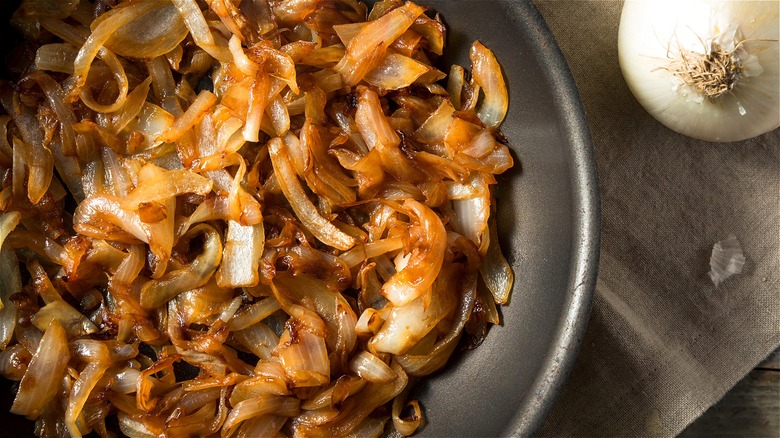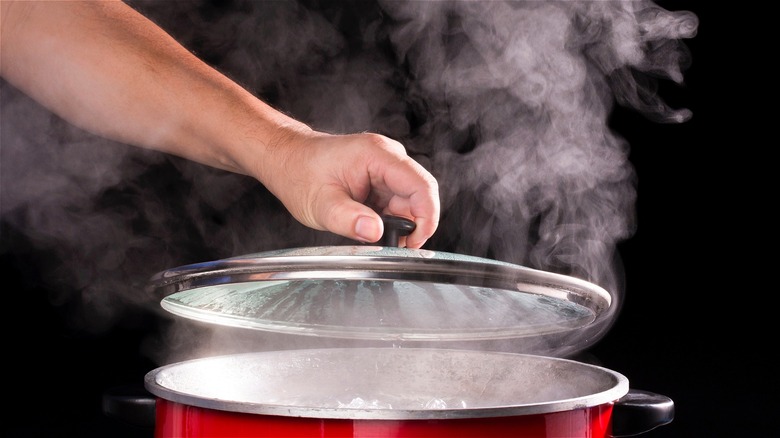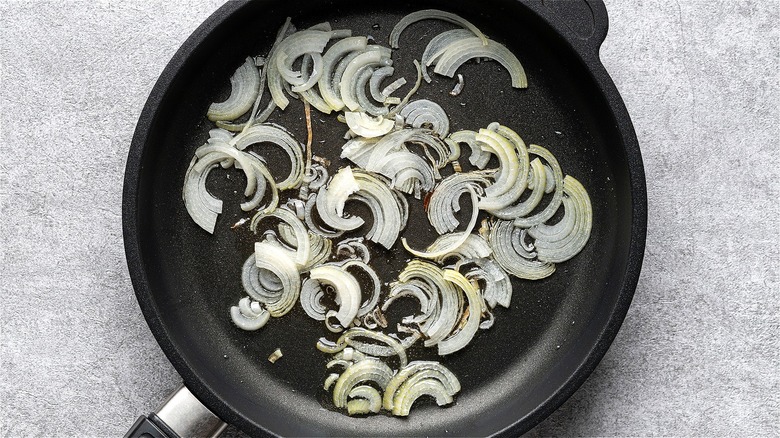Start Caramelizing Onions With The Lid On For Premium Results
Caramelized onions are one of those flavor-loaded foods that are well worth the extra effort. Whether you need a spoonful or two to upgrade your classic Swiss patty melt recipe, or a portion to enjoy alongside your weeknight steak or chicken dishes, caramelized onions are a surefire way to transform raw onions into a worthwhile side dish.
Traditionally, caramelized onions are made by cooking sweeter onion varieties down in a fat base of oil and butter over low heat for an extended period. The longer cooking time not only causes onions' natural sugars to break down or caramelize, but the Maillard reaction also takes place. The combining force of onions' amino acids and sugars over 285 degrees Fahrenheit creates a multitude of flavor compounds by way of browning. While these chemical processes lead to one sweet and savory side dish, how can you ensure that your sliced onions cook evenly over your stove?
Even though caramelized onions are procured over low heat, you may be able to cook these vegetables more efficiently up front by covering your skillet. Onions take a longer time for caramelization to occur due to their high moisture content. Steaming onions for a small amount of time by covering your pan at the start of this long-winded process allows you to get a head start in cooking all your onions in a unified fashion. Now, all you need to worry about is when to switch from steaming to cooking to achieve the ultimate level of browning and flavor development.
Use steam to create delicious caramelized onions
The biggest mistake you're making with caramelized onions may be moving too fast or utilizing high heat, but even with the low and slow method you can still achieve perfectly cooked onions with a bit of steam. Evenly browned onions require heat and direct contact with your skillet. Since every onion slice can't touch the base of your pan simultaneously, steam cooks onions efficiently before you need to begin stirring for even color and caramelization. With the lid firmly on your pan, onions will release extra moisture, which in turn, keeps each onion slice cooking at the same pace.
Now that you know how steam can be beneficial, when do you remove the lid from your skillet to start the essential caramelization process? Caramelized onions take roughly 45 minutes to cook, therefore you should devote no more than 20 minutes to steaming before you focus your efforts elsewhere. The extra moisture produced from steaming needs to evaporate for onions to take on a deepened hue. Allotting a solid 25 minutes of cooking with the lid removed allows excess moisture to cook off and gives your onions ample time to cook down into rich caramelized perfection. Interestingly enough, besides steaming, there are more ways you can achieve evenly cooked caramelized onions.
Surefire ways to produce evenly cooked caramelized onions every single time
Did you know there are 14 ways to take caramelized onions up a notch? Next to soaking your onions in lemon juice and properly deglazing your pan, apart from steaming, you can also secure perfectly cooked onions with a few easy steps. For starters, make sure your onions are cut into even slices. Extra thin onions run the risk of burning so aim to cut every onion in the same uniform size. Slices should be roughly ⅛ of an inch.
When cooking, make sure not to overcrowd your skillet. Caramelization and browning take longer when too many onions are included in the pan. The excess water produced needs to cook off before proper caramelization occurs. If you use more than 2 sizeable onions for one 12-inch pan, you need to allow more time for proper evaporation.
Now that you know how to effectively achieve evenly cooked caramelized onions, feel free to get creative by adding a bit of extra flair to this flavorful side. Play around with the idea of adding some color with bell peppers or upgrade the taste of these slow-cooked veggies to include a bit of black pepper or chili powder.


